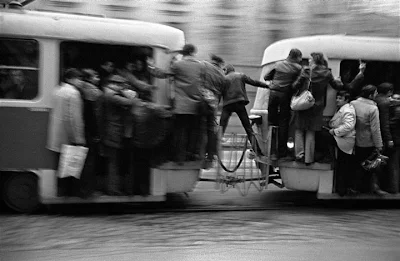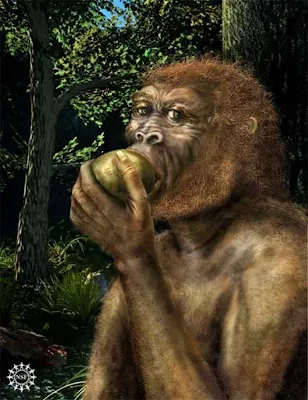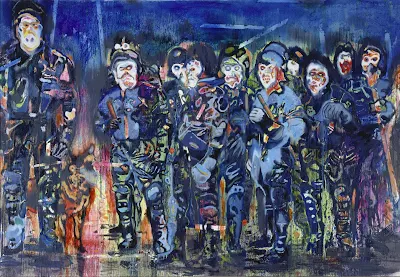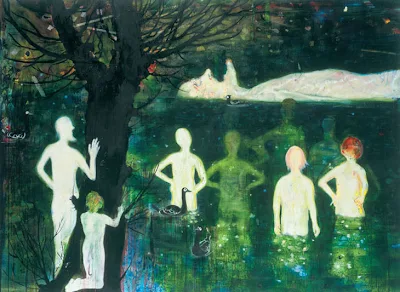Beneficial:
Far from hindering human development scientists now believe periods
of climate change helped us evolve
Μπορεί
το γεγονός ότι είμαστε έξυπνοι να
οφείλεται σε μια σειρά από αλλαγές στο
περιβάλλον; Αυτό υποστηρίζει μια ομάδα
ερευνητών που, ανατρέποντας την κρατούσα
θεωρία, διαπίστωσε ότι, σε μια περίοδο-κλειδί
στην πορεία της εξέλιξης του ανθρώπινου
είδους, το περιβάλλον στο οποίο ζούσαν
οι πανάρχαιοι πρόγονοί μας άλλαζε
συνεχώς ριζικά. Η ανάγκη προσαρμογής
σε αυτές τις ακραίες μεταβολές, λένε οι
ειδικοί, πυροδότησε την ανάπτυξη
ιδιαίτερων γνωσιακών και νοητικών
ικανοτήτων στους πρώτους ανθρώπους.
On
the move: An artist's impression of early human hunters crossing the
Bering Strait into North America around 25,000 years ago when
freezing temperatures caused a 330ft drop in the sea level
Συγκεκριμένα
οι αναλύσεις τους έδειξαν ότι την εποχή
της εμφάνισης του άμεσου προγόνου μας,
του Homo erectus, η Αφρική δεν «βίωνε» μια
παρατεταμένη περίοδο ξηρασίας διάρκειας
εκατομμυρίων ετών, όπως εθεωρείτο ως
τώρα. Αντιθέτως, γνώριζε πολύ συντομότερες
υγρές και ξηρές περιόδους που εναλλάσσονταν
μεταξύ τους με αποτέλεσμα το τοπίο να
μεταβάλλεται συνεχώς ανά μερικές γενεές
από ξηρή σαβάνα σε πλούσιους δασότοπους
και το αντίστροφο, αναγκάζοντας τα
ανθρωποειδή που ζούσαν εκεί να αναπτύξουν
νέες δεξιότητες για να μπορέσουν να
επιβιώσουν.
Στη
σαβάνα της Τανζανίας
Η
αλλαγή της διαθέσιμης τροφής εξαιτίας
της μεταβολής του περιβάλλοντος οδήγησε
στην αύξηση των γνωσιακών δεξιοτήτων
των πρώτων ανθρώπων Πηγή Nicolle Rager Fuller,
National Science Foundation
Οι
ερευνητές από τα πανεπιστήμια Penn State
και Rutgers μελέτησαν ιζήματα από το Φαράγγι
Ολντουβάι της Τανζανίας. Το φαράγγι
αυτό, το οποίο βρίσκεται στο ανατολικό
άκρο της Πεδιάδας Σερενγκέτι, θεωρείται
η «κοιτίδα» της ανθρωπότητας, αφού εκεί
έχουν βρεθεί τα απολιθώματα μερικών
από τα αρχαιότερα ανθρωποειδή. Οι
επιστήμονες επικέντρωσαν κυρίως το
ενδιαφέρον τους σε υπολείμματα κεριών
από φύλλα προκειμένου να διαπιστώσουν
τι φυτά ευδοκιμούσαν στην περιοχή σε
συγκεκριμένες χρονικές περιόδους πριν
από περίπου δυο εκατομμύρια χρόνια, την
εποχή δηλαδή κατά την οποία εμφανίστηκε
ο Homo erectus.
«Εξετάσαμε
τα κεριά των φύλλων επειδή είναι ανθεκτικά
και διατηρούνται καλά μέσα στα ιζήματα»
εξήγησε η Κάθριν Φρίμαν, καθηγήτρια
βιογεωχημείας στο Penn State και εκ των
επικεφαλής της μελέτης, η οποία
δημοσιεύθηκε στην επιθεώρηση «Proceedings
of the National Academy of Sciences».
Η
εξέταση των δειγμάτων με αέρια
χρωματογραφία και φασματομετρία μάζας
καθώς και η ανάλυση των ισοτόπων άνθρακα
έδειξαν ότι το περιβάλλον στο Φαράγγι
Ολντουβάι γνώριζε για μια μακρά χρονική
περίοδο μεγάλα «σκαμπανεβάσματα»: για
ένα διάστημα κυριαρχούσε η ανοιχτή
σαβάνα με τη χαμηλή βλάστηση αλλά αμέσως
μετά αυτή έδινε τη θέση της σε «κλειστά»
πυκνά δάση. Αυτή η εναλλαγή, όπως
διαπιστώθηκε, σημειώθηκε περίπου πέντε
ως έξι φορές μέσα σε διάστημα 200.000 χρόνων.
Ανατροπή
της «Μεγάλης Ξηρασίας»
Scorched:
A dry period 2million years ago which caused forests to disappear,
forced early humans to adapt to life on the grassy plains
Τα
ευρήματα αυτά έρχονται σε πλήρη αντίθεση
με την κρατούσα άποψη η οποία θεωρούσε
ότι την εποχή των πρώτων ανθρωποειδών
η Αφρική βρισκόταν σε μια παρατεταμένη
περίοδο προοδευτικής ξηρασίας – γνωστή
ως η «Μεγάλη Ξηρασία» – η οποία διήρκεσε
τρία εκατομμύρια χρόνια. «Τα δεδομένα
μας όμως δείχνουν ότι δεν επρόκειτο για
μια τεράστια, προοδευτική πορεία προς
την ξηρασία, αντιθέτως το περιβάλλον
ήταν εξαιρετικά μεταβλητό» τόνισε η δρ
Φρίμαν.
Από
την πλευρά του ο Κλέιτον Μαγκίλ,
τελειόφοιτος στις γεωλογικές επιστήμες
στο Penn State και εκ των συντελεστών της
μελέτης, επεσήμανε ότι η «ποικιλία» των
εμπειριών εξαιτίας της μεταβολής των
περιβαλλοντικών συνθηκών μπορεί να
πυροδοτήσει την ανάπτυξη των γνωσιακών
ικανοτήτων – μια άποψη η οποία είναι
διαδεδομένη στους ανθρωπολόγους.
During
the ice age, Neanderthals (above) thrived in Europe, Denisovians in
Asia and modern humans in Africa
«Οι
πρώτοι άνθρωποι περνούσαν από το να
έχουν στη διάθεσή τους δέντρα στο να
έχουν στη διάθεσή τους μόνο χόρτα μέσα
σε μόλις 10 ως 100 γενιές και η διατροφή
τους θα πρέπει να άλλαζε αναλόγως»
ανέφερε. «Οι μεταβολές στη διαθεσιμότητα
της τροφής, στο είδος της τροφής ή στον
τρόπο απόκτησής της μπορούν να πυροδοτήσουν
εξελικτικούς μηχανισμούς για την
αντιμετώπιση αυτών των αλλαγών. Το
αποτέλεσμα μπορεί να είναι η αύξηση του
μεγέθους του εγκεφάλου και της γνωσιακής
ικανότητας, αλλαγές στην κίνηση, ακόμη
και κοινωνικές αλλαγές».
Για
να στηρίξει ακόμη περισσότερο τα ευρήματά
της η ομάδα, στην οποία συμμετείχε επίσης
η Γκέιλ Ασλεϊ, καθηγήτρια γεωλογικών
και πλανητικών επιστημών στο Πανεπιστήμιο
Rutgers, ανέπτυξε στατιστικά και μαθηματικά
μοντέλα τα οποία συσχετίζουν τις
μεταβολές που αποκάλυψαν τα ιζήματα με
τη θερμοκρασία του νερού των γύρω ωκεανών
όπως και με τις μεταβολές στην τροχιά
της Γης (τους λεγόμενους «κύκλους του
Μιλάνκοβιντς») που έχουν ως αποτέλεσμα
την αυξομείωση της ηλιοφάνειας του
πλανήτη.



























.jpg)









.jpg)





.jpg)






